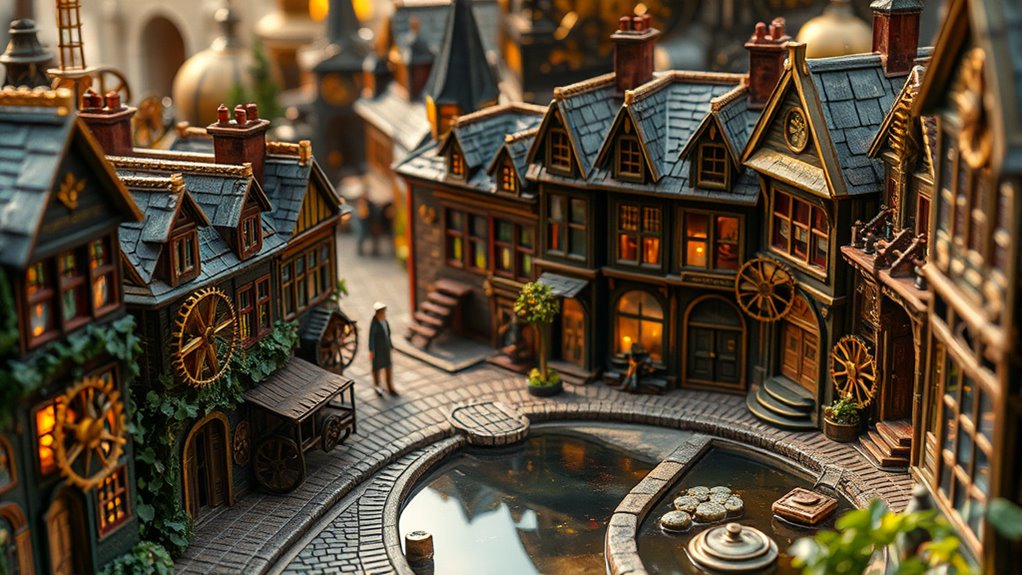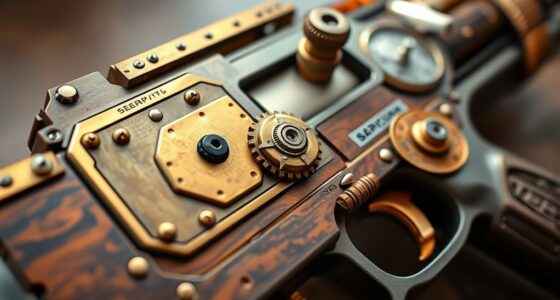To build miniature steampunk worlds, start with materials like plywood, EVA foam, and recycled plastic for unique textures. Incorporate elements like visible gears and clockwork for that industrial charm. Use techniques such as weathering for realism and create sturdy frames for your structures. Don't forget to design intriguing characters dressed in Victorian-inspired outfits. With lighting effects, you can bring your scenes to life and make them immersive. There's so much more to explore to enrich your creations!
Key Takeaways
- Utilize materials like wood, EVA foam, and recycled plastics to construct sturdy and detailed miniature structures.
- Research Victorian architecture and steam-powered technology for accurate and immersive environment design.
- Incorporate gears, clockwork mechanisms, and atmospheric lighting to enhance the steampunk aesthetics.
- Create unique characters with Victorian-inspired fashion and rich backstories to drive narrative depth.
- Apply weathering effects and textures for realism, encouraging exploration of intricate, fantastical worlds.
Materials for Crafting Miniatures
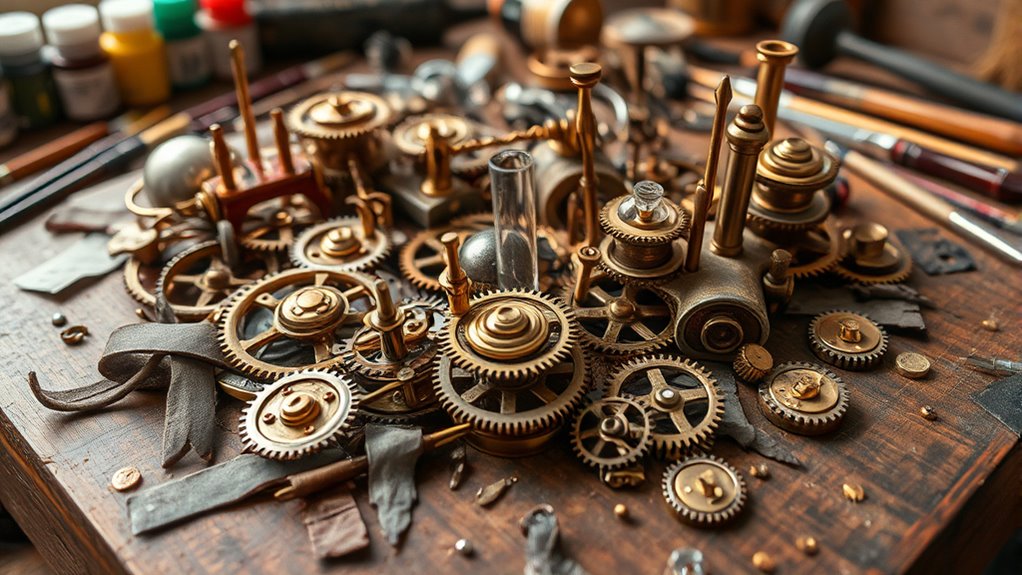
When you dive into crafting miniature steampunk worlds, the choice of materials can make all the difference.
Start with wood, like plywood or balsa, for sturdy structures. EVA foam's great for textured surfaces, while recycled plastic bottles can create intricate details. To enhance authenticity, incorporate metal elements such as copper tubing and metal rods. Don't forget about wires and rods for those mechanical parts! Additionally, consider using 18mm plywood for your base to ensure a solid foundation. Proper maintenance of your materials will also ensure that your creations remain durable over time. Incorporating natural elements into your designs can also elevate the overall aesthetic and authenticity.
Begin with plywood or balsa for durability; EVA foam adds texture, and recycled plastic bottles offer intricate detailing.
Textiles like leather and fabric can add a Victorian flair, while burlap gives a rustic touch. Use hardware like pipes and gauges to mimic industrial designs. For assembly, hot glue, wood glue, and contact cement are your best bets.
Combining these materials will help you bring your steampunk vision to life!
Techniques for Building Realistic Environments

After gathering the right materials for your miniature steampunk world, it's time to focus on techniques that bring your vision to life.
Start by researching and gathering references to understand essential elements like steam-powered technology and Victorian architecture. Determine your scale to ensure everything fits cohesively. Incorporating miniature model building can significantly enhance your understanding of spatial relationships within your scene.
Build a sturdy frame using foam board or balsa wood, keeping stability in mind. Add textures and apply weathering effects to enhance realism. Incorporate details like clockwork mechanisms and lighting to simulate atmosphere.
Plan your theme and perspective carefully, and consider environmental features like fog or smoke to enrich the scene.
Finally, don't forget the finishing touches that immerse viewers in your captivating diorama.
Incorporating Steampunk Aesthetics
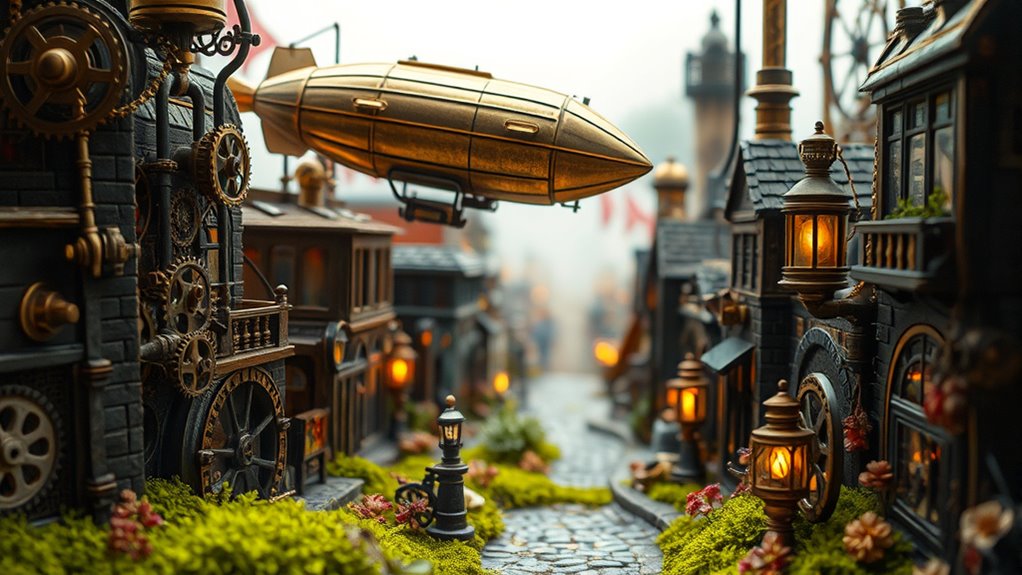
Incorporating steampunk aesthetics into your miniature world can transform it into a captivating blend of history and imagination.
Start by integrating technofantasy elements, like visible gears and clockwork mechanisms, which evoke an industrial charm. Emphasize hyper-vintage details inspired by the Victorian era, using vintage fashion accessories like top hats and goggles. Additionally, exploring smart shopping tips can help you find the best materials for your project. The philosophy of utilitarianism can guide your choices in balancing aesthetic appeal with functionality.
Combine retrofuturism with steam-powered vehicles, adding airships or trains for a unique twist. Incorporate historical elements that reflect cultural and social aspects of the past, enriching your scene. Steampunk's diverse interpretations allow for endless creativity in your designs, encouraging you to experiment with various styles and themes.
Don't forget to blend fantasy and science fiction, allowing for fantastical inventions alongside industrial structures. By thoughtfully weaving these elements together, you'll create a mesmerizing steampunk world that sparks curiosity and wonder.
Enhancing Storytelling With Miniatures
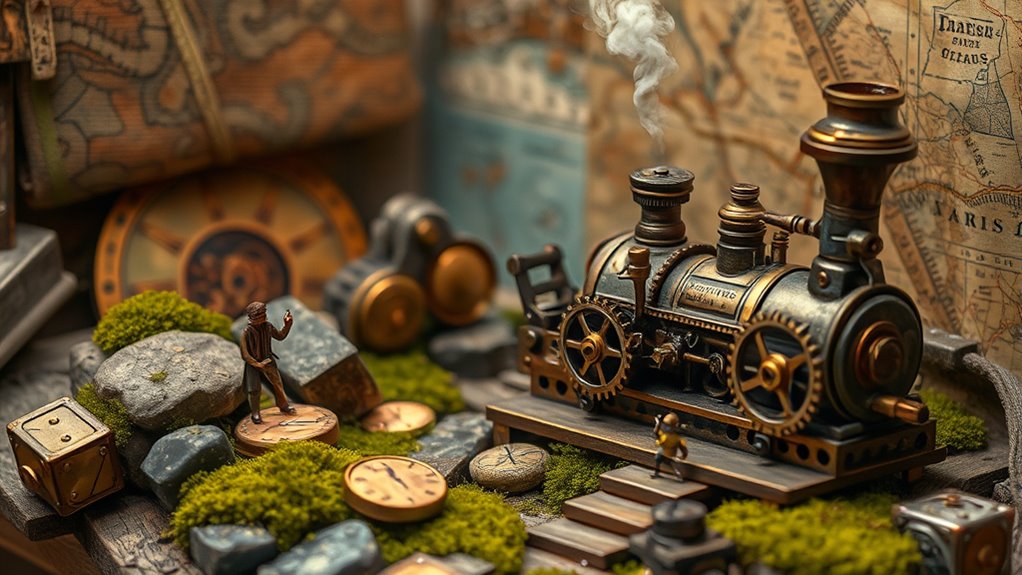
Miniature steampunk worlds create immersive storytelling experiences that transport you to alternate histories filled with imaginative technologies. By crafting detailed environments, you enhance world-building, making every scene rich with possibility.
The inclusion of steam-powered machines, from airships to clockwork gadgets, drives plot elements and creates a backdrop for adventure. You can explore "what if" scenarios, diving into conflicts shaped by technological innovations and their environmental impacts.
Layered storytelling emerges as you focus on character interactions and societal themes, bringing depth to your narratives. Use lighting effects and movement to engage viewers, allowing them to experience the story firsthand.
Ultimately, these miniatures not only visualize plots but also invite exploration of their intricate, fantastical worlds.
Designing Unique Steampunk Characters
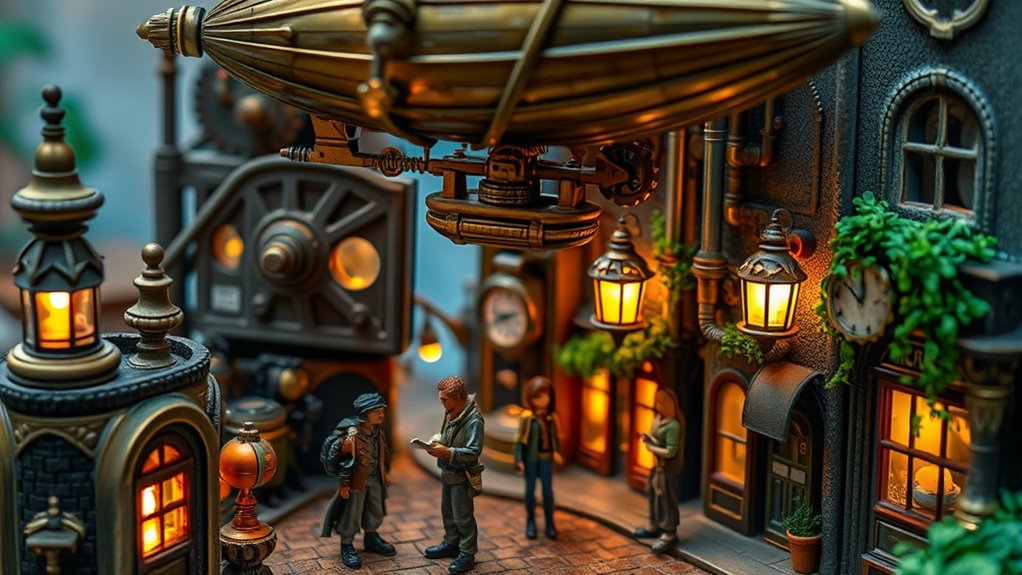
How do you breathe life into your steampunk characters? Start by choosing an archetype—perhaps an adventurous airship pirate or an eccentric inventor. Dress them in Victorian-inspired fashion, complete with leather accents and custom gadgets that reflect their profession. Don't forget unique accessories like goggles or clockwork prosthetics, which add character depth.
Next, infuse their personality with traits like curiosity and bravery. Establish a backstory that roots them in a reimagined historical context, detailing their family background or past events that shaped them. This not only gives them motivation but also connects them to your miniature world. Incorporating elements of steampunk culture can enhance their narrative, providing additional layers of intrigue. Additionally, consider how their experiences might influence their ability to embrace unconditional love, making them more relatable and complex. Finally, let their quirks shine through, making them memorable and engaging as they navigate the whimsical challenges of your steampunk universe.
Lighting and Finishing Touches for Atmosphere
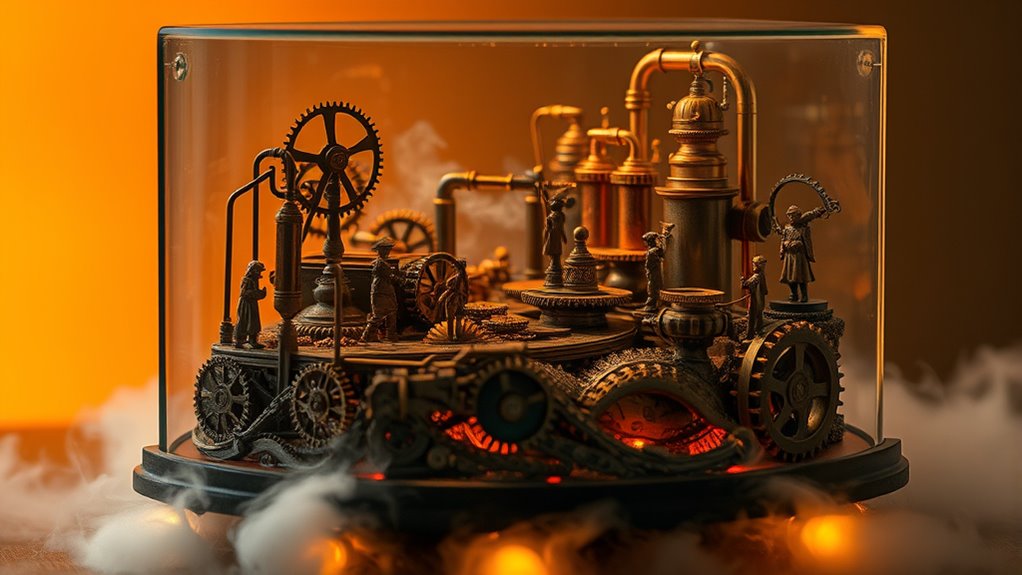
While designing your steampunk world, lighting plays a crucial role in shaping its atmosphere. Use warm white LEDs to evoke nostalgia or cool white for a more industrial vibe. Incorporate different light sources like lanterns and candles to add depth. Balance ambient lighting for overall illumination with accent lighting to highlight intricate details. Consider bi-color lighting to enhance realism. To create mystery, add fog or mist effects, and use lighting to emphasize textures on your machinery. Layer your set design for a three-dimensional space, and include water features for reflective effects. Finally, programmable LED lights can simulate steam-powered elements, while faux steam and smoke enhance the industrial feel, bringing your miniature world to life. Understanding light behavior is essential for achieving a convincing atmosphere.
Frequently Asked Questions
What Are Some Common Mistakes to Avoid When Building Miniatures?
When building miniatures, you should avoid common mistakes to ensure quality.
Don't skip instructions or rush through assembly; it can lead to misaligned parts. Always clean and prepare your pieces properly, and don't overuse glue, as it can ruin details.
Take your time with painting—uneven coats and smudges can ruin your work.
Lastly, pay attention to gaps and seams; neglecting them can detract from the overall realism of your model.
How Can I Create Moving Parts in My Diorama?
You might think creating moving parts in your diorama requires a magic wand, but it's much simpler!
Start by planning your layout, ensuring tracks and motors fit seamlessly. Use lightweight materials for the base, and incorporate small motors to bring vehicles to life.
Make sure to conceal mechanical components for a clean look. Finally, enhance realism with lighting and detailed landscaping, transforming your static scene into a dynamic spectacle that captivates viewers.
Where Can I Find Steampunk-Themed Accessories for Miniatures?
You can find steampunk-themed accessories for your miniatures at various places.
Check out online retailers like Etsy and Amazon for unique, handmade items and a broad selection of gears and cogs.
Local hobby stores often carry specialized miniature accessories, while hardware stores like Home Depot offer materials you can repurpose.
Don't forget thrift shops for vintage finds!
Online communities and forums are also great for discovering new sources and inspiration.
What Are the Best Resources for Learning Advanced Miniature Techniques?
To learn advanced miniature techniques, explore online tutorials, join vibrant communities, and watch expert videos.
Check out Creative Twilight for guides, Wargames Delivered for tutorials, and Age of Miniatures for tips on various methods.
Use YouTube to find step-by-step painting tips, and engage in forums for valuable feedback.
Experiment with different paints, document your progress, and challenge yourself regularly to refine your skills and elevate your painting game.
How Do I Store and Display My Finished Miniature Worlds?
To store and display your finished miniature worlds, use containers with removable dividers for various sizes.
Consider modular drawers for organization and larger shelves for display. Protect your miniatures with glass-top cases to keep them dust-free.
Utilize wall-mounted shelves for space efficiency and add LED lighting to enhance their appeal.
Regularly dust with a soft brush and store them in airtight containers to maintain their condition.
Keep your collection organized for easy access.
Conclusion
By diving into miniature steampunk worlds, you're not just crafting; you're breathing life into a captivating universe where gears and dreams collide. Whether you're assembling intricate details or designing unique characters, each piece tells a story that sparks the imagination. With your newfound techniques and a dash of creativity, you'll create environments that transport viewers to another time. So grab your tools and let your visions take flight, as you build your own whimsical realm of wonder!
